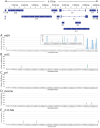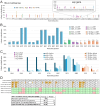This is a preprint.
An HIV-1 Reference Epitranscriptome
- PMID: 39975020
- PMCID: PMC11838527
- DOI: 10.1101/2025.01.30.635805
An HIV-1 Reference Epitranscriptome
Abstract
Post-transcriptional modifications to RNA, which comprise the epitranscriptome, play important roles in RNA metabolism, gene regulation, and human disease, including viral pathogenesis. Modifications to the RNA viral genome and transcripts of human immunodeficiency virus 1 (HIV-1) have been reported and investigated in the context of virus and host biology. However, the diversity of experimental approaches used has made clear correlations across studies, as well as the significance of the HIV-1 epitranscriptome in biology and disease, difficult to assess. Therefore, we established a reference HIV-1 epitranscriptome. We sequenced the model NL4-3 HIV-1 genome from infected primary CD4+ T cells and the Jurkat cell line using the latest nanopore chemistry, optimized RNA preparation methods, and the most current and readily available base-calling algorithms. A highly reproducible sense and a preliminary antisense HIV-1 epitranscriptome were created, where N6-methyladenosine (m6A), 5-methylcytosine (m5C), pseudouridine (psi), inosine, and 2'-O-methyl (Nm) modifications could be identified by rapid multiplexed base-calling. We observed that sequence and neighboring modification contexts induced modification miscalling, which could be corrected with synthetic HIV-1 RNA fragments. We validated m6A modification sites with STM2457, a small molecule inhibitor of methyltransferase-like 3 (METTL3). We find that modifications are quite stable under combination antiretroviral therapy (cART) treatment, in primary CD4+ T cells, and in HIV-1 virions. Sequencing samples from people living with HIV (PLWH) revealed conservation of m6A modifications. However, analysis of spliced transcript variants suggests transcript-dependent modification levels. Our approach and reference data offer a straightforward benchmark that can be adopted to help advance rigor, reproducibility, and uniformity across HIV-1 epitranscriptomics studies. They also provide a roadmap for the creation of reference epitranscriptomes for many other viruses or pathogens.
Figures




References
-
- Aksamentov I., Roemer C., Hodcroft E., and Neher R. (2021). Nextclade: clade assignment, mutation calling and quality control for viral genomes. Journal of Open Source Software 6, 3773.
-
- Asang C., Erkelenz S., and Schaal H. (2012). The HIV-1 major splice donor D1 is activated by splicing enhancer elements within the leader region and the p17-inhibitory sequence. Virology 432, 133–145. - PubMed
Publication types
Grants and funding
LinkOut - more resources
Full Text Sources
Research Materials
